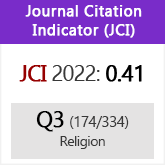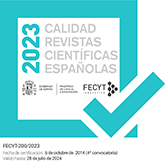Convergencias y divergencias lingüísticas con el judeoespañol castizo de un traductor nativo de inglés. El caso del Ele Toledot Bené Yisrael (Constantinopla, 1854 y 1886) del Rev. Alexander Thomson
DOI:
https://doi.org/10.3989/sefarad.020-006Palabras clave:
Adquisición de lengua extranjera, literatura pedagógica, misioneros protestantes, Imperio otomano, siglo XIXResumen
A pesar de la existencia de una opinión negativa generalizada sobre el judeoespañol empleado por los misioneros protestantes, no existen actualmente estudios que expliquen de manera exhaustiva las diferentes características lingüísticas del idioma producido por estos cristianos, así como tampoco que hagan una investigación que analice la evolución de estas en el tiempo. En las próximas páginas mostraremos el caso particular del reverendo escocés Alexander Thomson (1820-1899), quien tradujo del inglés al judeoespañol diferentes obras en la década de 1850 en Constantinopla y posteriormente las retradujo entre mediados y finales de la década de 1880. De este modo, podremos atestiguar cómo evoluciona el uso de la lengua sefardí en un hablante no nativo a través de sus textos traducidos a lo largo de tres décadas.
Descargas
Citas
Başaran, Betül (1997): Reinterpreting American Missionary Presence in the Ottoman Empire: American Schools and the Evolution of Ottoman Educational Policies (1820-1908) (Ankara: Bilkent University).
Bible Stories for the young, by C. G. Barth, D. D. Old and New Testaments. Translated from the 31th German edition (London: The Religious Tract Society, 1851).
Binder, Katrin (2006): «A Garland of Stories: Kathamale», en Reinhard Wendt (ed.) An Indian to the Indians? On the Initial Failure and the Posthumous Success of the Missionary Ferdinand Kittel (1832-1903) (Wiesbaden: Harrassowitz Verlag) pp. 231-255.
Breitenbach, Esther (2005): Empire, Religion and National Identity: Scottish Christian Imperialism in the 19th and early 20th Centuries (Edinburgh: University of Edinburgh).
Bunis, David M. (1992): «The language of the Sephardim: A historical overview», en Moreshet Sepharad: The Sephardi legacy (Jerusalem: The Magnes Press-The Hebrew University) pp. 399-442.
Bunis, David M. (2017): «The lexicography of Sephardic Judaism», en Patrick Hanks y Gilles-Maurice Schryver (eds.) International Handbook of Modern Lexis Lexicography (Berlin-Heidelberg: Springer) pp. 1-25. https://doi.org/10.1007/978-3-642-45369-4_72-1
Bunis, David, Joseph Chetrit y Haiden Sahim (2003): «Jewish Languages Enter the Modern Era», en R. Spector Simon, M. Menachem Laskier, and S. Reguer (eds.) The Jews of the Middle East and North Africa in Modern Times (New York: Columbia University Press) pp. 113-141.
García Moreno, Aitor (2013): «¿Ante el primer diccionario monolingüe judeoespañol?», Sefarad 73:2, pp. 371-408. https://doi.org/10.3989/sefarad.010.012
García Moreno, Aitor (2018): «Poemas castellanos en textos sefardíes: ejemplos en La escalera a la anṿeźadura [Constantinopla 1853 y 1888]», Sefarad 78:1, pp. 149-200. https://doi.org/10.3989/sefarad.018.005
García Moreno, Aitor y Francisco Javier Pueyo Mena (2013-): Corpus Histórico Judeoespañol - CORHIJE, recurso en línea accesible en <http://recursos.esefardic.es/corhije>.
Lazar, Moshe (1994): «Apéndice: Ladinamientos aljamiados de la Biblia», en Iacob M. Hassán y Ángel Berenguer (eds.) Actas del Simposio Internacional sobre la Biblia de Ferrara (Madrid: Consejo Superior de Investigaciones Científicas) pp. 373-442.
Park, Edwards A. (ed.) (1887): Autobiography of William. G. Schauffler, for forty-nine years a missionary in the Orient (New York: Anson D. F. Randolph & Company).
Quintana Rodríguez, Aldina (1999): «Proceso de recastellanización del judesmo», en Judith Tarragona Borrás y Ángel Sáenz Badillos (eds.) Jewish Studies at the Turn of the Tweentieth Century (Leiden-Boston-Köln: Bril,) pp. 593-602.
Romero, Elena (1992): La creación literaria en lengua sefardí (Madrid: Mapfre).
Ross, John S. (2003): «An Introduction to Two Thousand Years of Jewish Evangelism», Haddington House Journal 5, pp. 53-65.
Séfer Torá, Nebiím veKetubim / El libro de la Ley, los Profetas y las Escrituras, trasladado en la lengua española (Constantinopla: A. H. Boyaciyan, 1873).
Sephiha, Haim Vidal (2001): «The instruction of Judeo-Spanish in Europe», Sophar 19, pp. 58-70. https://doi.org/10.1353/sho.2001.0120
Sisman, Cengiz (2015): «Failed Proselytizers or Modernizers? Protestant Missionaries among the Jews and Sabbateans/Dönmes in the Nineteenth-Century Ottoman Empire», Middle Eastern Studies 51:6, pp. 932-949. https://doi.org/10.1080/00263206.2015.1044526
The Home and Foreign Record of the Free Church of Scotland, August 1856-July 1857. Volumen I New Series (Edinburgh: James Nichol - London: James Nisbet).
Thomson, Alexander (1888): La escalera a la anṿeźadura (Constantinopla: A. H. Boyaciyan).
Walker, Norman L. (1895): Chapter from the history of the Free Church of Scotland (Edinburgh-London: Oliphant Anderson & Ferrier).
Zweymal zwey und fünfzig Biblische Geschichten für Schulen und Familien (Calw: Johann Ludwig Federhaff, 1832).
Descargas
Publicado
Cómo citar
Número
Sección
Licencia
Derechos de autor 2020 Consejo Superior de Investigaciones Científicas (CSIC)

Esta obra está bajo una licencia internacional Creative Commons Atribución 4.0.
© CSIC. Los originales publicados en las ediciones impresa y electrónica de esta Revista son propiedad del Consejo Superior de Investigaciones Científicas, siendo necesario citar la procedencia en cualquier reproducción parcial o total.Salvo indicación contraria, todos los contenidos de la edición electrónica se distribuyen bajo una licencia de uso y distribución “Creative Commons Reconocimiento 4.0 Internacional ” (CC BY 4.0). Puede consultar desde aquí la versión informativa y el texto legal de la licencia. Esta circunstancia ha de hacerse constar expresamente de esta forma cuando sea necesario.
No se autoriza el depósito en repositorios, páginas web personales o similares de cualquier otra versión distinta a la publicada por el editor.














